Kunri
| Kunri Urdu: كُنرى Sindhi: ڪنري | |
|---|---|
| City |
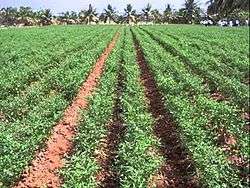
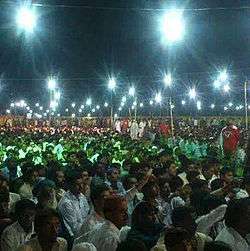
Kunri (Urdu: كُنرى), (Sindhi: ڪنري) is a taalqa and a town located in the Umarkot District, Sindh province in the southern part of Pakistan.[1] It is about 300 miles (480 km) from Karachi, one of the largest cities in Pakistan. It has a population of about 100,000. It is the red chili capital of Asia. Kunri's red chili is very important to the domestic as well international markets; as a result, it attracts Chinese buyers all the way from Hong Kong who need chilies to make their chili sauce.
Demographics
The population is composed mostly of spiritual Muslims, the long line of local dervishes (waliullahs or walis) who are so great that this article space will be too small to write their details, is very prominent in the area and Bibi Mithi Cemetery is an area of their burial, this cemetery is named after the prominent dervish matriarch of the local Hashmani Kazmi clan of Syeds whose tip of the tongue was black, whatever she said came out true. Her shrine is located at this graveyard visited by many of her followers. Other big shrine is that of Shah Bilawal with its own tiny cemetery a few miles of Kunri town, visited by people of high and mighty spiritual elevation.
There are small numbers of Christian, Kashmiri, Qadyanies and Hindus, in part due to the fact that many people decided not to move to India during the independence of Pakistan in 1947 because of Kunri's Sufi and tolerant culture. It is here that the Hindus wear their dress without feeling awkward or feeling the need "to dress as the Romans do". Kunri also has a population of Arain tribesmen from Punjab and the Sindhi Arain. Bhatti, Marwari,Pakhtuns, Baloch and other communities also live here.
Economy
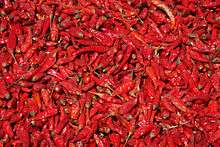
Kunri's economy is mostly based on agriculture. The region produces different types of crops, including red chilies (planted in approx. 88,000 acres around the Kunri area), cotton, sunflower, sugar cane, and the world-famous Sindhri mangoes. Having a mango orchard is a must if you belong to this area. By far, the most popular crop in Kunri is the red chili, which sustains the financial structure of the town. Kunri is known as the biggest red chili market in Pakistan. There are few small and one big cooking oil plants located in Kunri, most of which only provide employment to needy people in the city. The women are highly skilled in Sindhi embroidery such as Hurmacho (interlacing stitch), mirror work, and applique work quilts called rillies. Balochi emberoidery known as "Kharek" is also beautiful on dresses made by the local Sindhi-Baloch ladies. Cottage industries need to be set up to take advantage of these talented people.
Culture
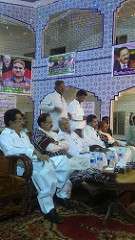
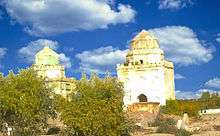
Culture is friendly, non racist, without a monetary caste system, they don't give you a tit for tat if you act badly but simply keep their mouth shut and eyes open because talking back or giving a reply to an bad comment is considered bad manners in Sindhi culture and a person doing so is considered a loser to say the least. In short, they are humble with high morals. Many languages are spoken here but there is never friction as to who is the greatest. Jeeps are widely used as well as cars in this area because a jeep usually has a four-wheel to make a quick trip to nearby Thar dessert if need be. Muslims wear
Salvaar Kamees, older ladies tend to wear traditional hand made shoes or juttees and some Hindu and Christian women wear ghagra and the bangles from shoulders to wrists which were made of pure ivory in the not so distant past but nowadays are made of plastic as is the cultural and historical dress. It is common for women of Kunri to work outside their homes in the cotton fields, chili fields, and mango orchards; however middle and upper class women do not work outside their homes and live sheltered lives. There is also a notable Baloch neighborhood in Kunri who speak the Southern dialect of Balochi. Yet there are many who speak the mainstream Balochi dialect generally spoken in Sindh. People of many castes like Meghvaar, Kolhi, Bheel, Punjabi, Pathan, Khaskheli, Marwari, Kupri also live in this area.[2] Kupri dervishes spanning more than half a dozen generations are also notably very respected in this area. Building style consists of the typical Blue tiles of Kashi which the architecture of Sindh is noted for.
Transportation
Transportation consists mostly of private cars, public uses rickshaws, three-wheeled motorcycles, and bicycles. There are buses that enable the citizens of Kunri and fruits of their hard labor (such as chilies, cotton, wheat, sunflower) and cattle for meat consumption to travel as far as Karachi, from Karachi the chilies are loaded into the containers and shipped to Germany, Hong Kong, Switzerland, and the US among many other countries. Still public transportation is a problem in the city; the only road joining Kunri to Mirpurkhas is in bad condition and requires constant repair. However, the transportation system is continually being improved. The railway station at Kunri needs to be improved to better than economy though.
Weather
Kunri is relatively cold in winter, around 3-12 Celsius. In summer the temperature is very hot, reaching up to 46 Celsius, and dust storms are frequent. The average rainfall is about 100 millimeters. It rains heavily in the Monsoon season, sometimes inundating the lands and the unprotected chili crop as well as other cash crops.
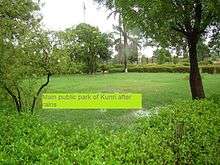
Nabisar Road
Nabisar Road is situated in Kunri Taluka. It is one of oldest towns in Pakistan. The Nabisar Road railway station was built in 1935.[3][4][5]
Notes
- ↑ Irwin p100
- ↑ Walbridge, p. 117
- ↑ "Pakistan Railways" (PDF). Pakistan Railway.
Nabisar Road
- ↑ "Dawn Article". Dawn.
Nabisar Road
- ↑ "Dawn Article". Dawn.
Nabisar Road
References
- Phyllis Irwin M D. Dr. Memsaab: Stories of a Medical Missionary Mom. AuthorHouse. 18 June 2010. ISBN 978-1-4520-2538-4
- Linda S. Walbridge. The Christians of Pakistan: the passion of Bishop John Joseph. Routledge. 1st edition. 19 September 2002. ISBN 978-0-7007-1656-2